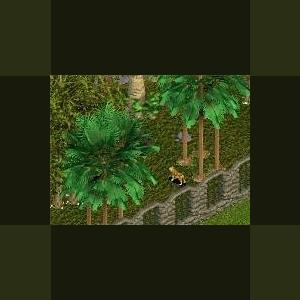About This File
With a silhouette and footprint resembling a house cat, the oncilla is small, having an average weight of 2.5 kg, with males slightly larger than females. The oncilla closely resembles the margay, and the two can be difficult to distinguish in the field. The two cats are similarly marked, but the oncillas pattern of rosettes tends to be less dark and blotchy than the margay's, its fur is not as thick, its body is more slender, and its tail not as long. Melanistic individuals are occasionally reported. Prey consists of small mammals (rodents and shrews), birds, small reptiles, and amphibians. Oncillas have been reported to prey on small primates in Brazil.
After a gestation period of about 75-78 days, the female oncilla will give birth to a litter of one to three cubs with one as most common. Born blind, the kittens eyes will open at approximately ten days of age. The kittens will be nursed until about 12 weeks of age at which time they will begin an exclusive diet of prey items brought to them by their mother. The kittens will stay with their mother until they are about one year of age. sexual maturity for females occurs at about 12-15 months of age, and at 18-24 months for males. In captivity, oncillas have been known to live up to 20 years. In the wild, they probably live until about 12 to 15 years of age.
The oncilla shows a strong preference for montane cloud forest, in that it is found at higher elevations than the ocelot and margay. In eastern Brazil, it is present in the subtropical forest highlands. There are also reports it has been found in early secondary forests and abandoned eucalyptus plantations, in areas close to human settlement, and highly affected by deforestation and fire. Oncillas have also been found in semi-arid thorny scrub in north-east Brazil and in dry deciduous forest in northern Venezuela. To what degree the oncilla uses lowland moist forest is not clear, especially within the Amazon basin. It has not been reported from this area.
the oncilla appears to have a naturally disjunct distribution, although further research is necessary to confirm this. The northernmost record is from northern Costa Rica, near the Tapantm Cloud Forest Faunal Refuge. It has been recorded from northern Panama, but the remainder of the country appears to be a gap in the species' range. The oncilla is probably found throughout Panama, as habitat there is suitable. There are only two museum specimens for Ecuador and Peru. There are no museum records for Bolivia.
There is little known about the population status of this species. This species has never been studied in the wild, and there is little understanding of its habitat requirements, density, and coexistence with other small cats. It has been trapped in large numbers for the fur trade -- in 1971, 28,000 pelts were counted in Brazilian warehouses, and in 1983, 84,500 skins were exported from Paraguay --although it is likely that other spotted cat pelts were mixed with oncilla. It is rarely seen by field biologists.
The oncilla is protected over part of its range with hunting prohibited in Argentina, Brazil, Colombia, Costa Rica, French Guiana, Paraguay, Suriname, Venezuela. It has no legal protection in Ecuador, Guyana, Nicaragua, Panama, or Peru.
It is difficult to assess threats to the oncilla when so little is known about it. Coffee plantations are often established in cloud forest habitat, but observations of it in deforested areas and eucalyptus monoculture on the outskirts of Sao Paolo suggest tolerance of habitat alteration. Although international trade effectively ceased after 1985, 675 spotted cat skins, mainly oncilla, were seized in Brazil, but came from Paraguay. The age of the pelts, however, was not ascertained.
Updated 2010-11-05
Just to save space with less in zip and smaller image.
Nothing new.
Update: 5 June 2011
Updated by johnrn1 to have it no longer be invisible, to have it not be configured as a jumper (since it does not have jumping graphics), to have the preferred object tooltip appear for the female and young, to have it play in-game sounds when picking up and placing it, to make the configuration file more efficient, and to correct grammar problems in the tooltip and animal info text.



Recommended Comments
Create an account or sign in to comment
You need to be a member in order to leave a comment
Create an account
Sign up for a new account in our community. It's easy!
Register a new accountSign in
Already have an account? Sign in here.
Sign In Now